
As Oliver Hardy once commented to Stan Laurel, “Well, we’re in it.” So said the rest of the country, as President Roosevelt’s decree placed us officially at war with the Axis. As our survey of flight cartoons continues, the industry had also shifted gears, no longer needing to pull its punches about who were the bad guys or whether we were merely playing at war or really battling. Everyone knew there was a “job to be done”, and patriotic spirit was being drummed up with a vim. Thus, cartoons in general took on a more aggressive tone – something that animators, well familiar with the entertainment value of violence, were certainly not unacquainted with. Animation began to prove an effective medium for spreading wartime themes, mottos, etc., in ways that would be more likely to stick in an audience’s memory than a stoic speech from your favorite screen or radio personality asking you to buy bonds. Even in the most lighthearted of films, topical wartime references were likely to pop up, leading to the inevitable coverage of wartime air activity turning up in the unlikeliest of places.
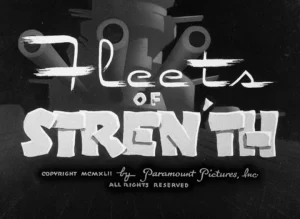 Fleets of Stren’th (Fleischer/Paramount, Popeye, 3/13/42 – Dave Fleischer, dir., Al Eugster/Tom Golden, anim.), is another action-packed chapter in Popeye’s service career in the modern Navy. It begins with an unusual opportunity for a self-plug of the Fleischers’ latest prestige project, of which we will see a sample below. Popeye is seen reading a Superman comic, commenting, “That Superman is pretty good. Well, I can’t be as strong as Superman and handsome too.” (Jack Mercer (voice of Popeye) receives writing credit together with Dan Gordon on this story – I’d guess Mercer penned this line himself.) He is interrupted by a clearing of throat behind him, where the Captain stands observing him. Popeye snaps to attention, his feet neatly shuffling to fold up the comic into a compact wad, and kick it into his back pocket. The Captain orders him to load a torpedo into a mosquito boat, which Popeye performs the hard way – by dropping the torpedo overboard at the small ship below, then darting down several flights of stairs within the larger ship to catch the torpedo from a side hatchway before it hits the smaller vessel. The Captain orders Popeye back on deck, and insists that the Navy requires strict discipline. He puts Popeye through a close-order drill, then leaves him standing at stiff attention, as the sounds are heard of an enemy dive bomber dropping a payload of bombs close to the ship’s side. An expletive is covered by the sounds of explosions, as the Captain, forgetting Popeye entirely, orders his crew to “Blow that dirty __________ right out of the sky!” Popeye, believing he has still not been relieved from the Captain’s last order, stays as motionless as a statue, while the plane swoops by him so low that it blows his hat off, then drops a bomb in front of him, blasting him off the deck and up to the very top of the mainmast. “What are you standing there for? Get that plane”, booms the captain’s voice. She’s as good as got”, responds Popeye, swinging into action. Diving from the spars and rigging, Popeye mans the mosquito boat, taking aim at the plane with its machine gun. But the plane keeps dropping bombs in the water on either side of him, dipping the bow of the boat into the water, and bouncing the craft atop the waves like a stone skipping along the surface.
Fleets of Stren’th (Fleischer/Paramount, Popeye, 3/13/42 – Dave Fleischer, dir., Al Eugster/Tom Golden, anim.), is another action-packed chapter in Popeye’s service career in the modern Navy. It begins with an unusual opportunity for a self-plug of the Fleischers’ latest prestige project, of which we will see a sample below. Popeye is seen reading a Superman comic, commenting, “That Superman is pretty good. Well, I can’t be as strong as Superman and handsome too.” (Jack Mercer (voice of Popeye) receives writing credit together with Dan Gordon on this story – I’d guess Mercer penned this line himself.) He is interrupted by a clearing of throat behind him, where the Captain stands observing him. Popeye snaps to attention, his feet neatly shuffling to fold up the comic into a compact wad, and kick it into his back pocket. The Captain orders him to load a torpedo into a mosquito boat, which Popeye performs the hard way – by dropping the torpedo overboard at the small ship below, then darting down several flights of stairs within the larger ship to catch the torpedo from a side hatchway before it hits the smaller vessel. The Captain orders Popeye back on deck, and insists that the Navy requires strict discipline. He puts Popeye through a close-order drill, then leaves him standing at stiff attention, as the sounds are heard of an enemy dive bomber dropping a payload of bombs close to the ship’s side. An expletive is covered by the sounds of explosions, as the Captain, forgetting Popeye entirely, orders his crew to “Blow that dirty __________ right out of the sky!” Popeye, believing he has still not been relieved from the Captain’s last order, stays as motionless as a statue, while the plane swoops by him so low that it blows his hat off, then drops a bomb in front of him, blasting him off the deck and up to the very top of the mainmast. “What are you standing there for? Get that plane”, booms the captain’s voice. She’s as good as got”, responds Popeye, swinging into action. Diving from the spars and rigging, Popeye mans the mosquito boat, taking aim at the plane with its machine gun. But the plane keeps dropping bombs in the water on either side of him, dipping the bow of the boat into the water, and bouncing the craft atop the waves like a stone skipping along the surface.
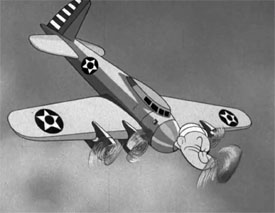 When Popeye rights the craft, the gun is water logged, and only shoots a steam of fish like a water pistol. The plane, meanwhile, returns to its mother base at a huge aircraft carrier, and its wing comes to life, bending to beckon other planes to follow. A seemingly endless armada of planes begins to rise from the deck. Popeye turns his ship in tactical retreat, but the planes relentlessly pursue. One catches Popeye’s feet in its propeller blades, while Popeye desperately tries to hang onto the ship’s wheel, twisting him around in a braid. Another dives so low, Popeye has to jump and run over the top of the plane to avoid collision. A third alternates between high and low tracer fire with its machine guns, causing Popeye to impossibly compress himself to stay between the lines of fire. Then, a series of planes passes over him, dipping their tails down to bash Popeye in the head with their elevator and rudder panels. Yet another plane, with remarkably flexible landing gear, grabs hold of Popeye’s mosquito boat between its wheels, and crushes the vessel like it was a matchbox, dumping Popeye into the ocean. Two planes approach from either side, both dropping torpedoes in Popeye’s direction. Popeye is contemplating his spinach, but doesn’t have time to open the can, instead ducking under the water to let the torpedoes collide with each other. The explosion blows Popeye high into the air, where a plane zeroes in with its machine gun fire. Now Popeye gets the spinach can open, by letting the bullets do the work for him, cutting into the can lid like an opener. His pipe spinning and arms outstretched, Popeye zooms through the air, momentarily transformed into the image of a four engine heavy fighter. As the enemy plane continues to shoot, Popeye catches the bullets in his bare hands, swallows them, then shoots them out his mouth, carving away the enemy’s prop to send it into a crash dive. Popeye grabs the tails of two more planes and ties them together, so that their engines pull each other’s fabric off, exposing the planes’ bare metal framework. Popeye next performs a trapeze act from one plane’s landing gear to another to another, removing the props off two of them, and turning the third upside down. Standing on the belly of the inverted plane, Popeye performs a juggling act with three aerial bombs dropped to him, then tosses the bombs back for direct hits on the planes that threw them, set to the notes of the NBC chimes. A new round of ten fighters launches from the flight deck, and Popeye repeats his old bit from “Ali Baba’s Forty Thieves”, taking a spare aerial bomb, pitching it through the air, and scoring a bowling strike on the squadron. These last planes fall back to the deck of the carrier, engulfing the ship in black explosion clouds. The final shot shows Popeye using a mast as a giant rowing oar, aboard the bow of the bombed-out hulk of the carrier, rowing it back to his ship as a war prize, with visible holes in the front bow in the shape of a V and a dot dot dot dash, synonymous with the key notes of Beethoven’s 5th Symphony that became a call for victory throughout the wartime years.
When Popeye rights the craft, the gun is water logged, and only shoots a steam of fish like a water pistol. The plane, meanwhile, returns to its mother base at a huge aircraft carrier, and its wing comes to life, bending to beckon other planes to follow. A seemingly endless armada of planes begins to rise from the deck. Popeye turns his ship in tactical retreat, but the planes relentlessly pursue. One catches Popeye’s feet in its propeller blades, while Popeye desperately tries to hang onto the ship’s wheel, twisting him around in a braid. Another dives so low, Popeye has to jump and run over the top of the plane to avoid collision. A third alternates between high and low tracer fire with its machine guns, causing Popeye to impossibly compress himself to stay between the lines of fire. Then, a series of planes passes over him, dipping their tails down to bash Popeye in the head with their elevator and rudder panels. Yet another plane, with remarkably flexible landing gear, grabs hold of Popeye’s mosquito boat between its wheels, and crushes the vessel like it was a matchbox, dumping Popeye into the ocean. Two planes approach from either side, both dropping torpedoes in Popeye’s direction. Popeye is contemplating his spinach, but doesn’t have time to open the can, instead ducking under the water to let the torpedoes collide with each other. The explosion blows Popeye high into the air, where a plane zeroes in with its machine gun fire. Now Popeye gets the spinach can open, by letting the bullets do the work for him, cutting into the can lid like an opener. His pipe spinning and arms outstretched, Popeye zooms through the air, momentarily transformed into the image of a four engine heavy fighter. As the enemy plane continues to shoot, Popeye catches the bullets in his bare hands, swallows them, then shoots them out his mouth, carving away the enemy’s prop to send it into a crash dive. Popeye grabs the tails of two more planes and ties them together, so that their engines pull each other’s fabric off, exposing the planes’ bare metal framework. Popeye next performs a trapeze act from one plane’s landing gear to another to another, removing the props off two of them, and turning the third upside down. Standing on the belly of the inverted plane, Popeye performs a juggling act with three aerial bombs dropped to him, then tosses the bombs back for direct hits on the planes that threw them, set to the notes of the NBC chimes. A new round of ten fighters launches from the flight deck, and Popeye repeats his old bit from “Ali Baba’s Forty Thieves”, taking a spare aerial bomb, pitching it through the air, and scoring a bowling strike on the squadron. These last planes fall back to the deck of the carrier, engulfing the ship in black explosion clouds. The final shot shows Popeye using a mast as a giant rowing oar, aboard the bow of the bombed-out hulk of the carrier, rowing it back to his ship as a war prize, with visible holes in the front bow in the shape of a V and a dot dot dot dash, synonymous with the key notes of Beethoven’s 5th Symphony that became a call for victory throughout the wartime years.
These wartime Popeyes, always pitting our hero against impossible odds, are a bit unnerving, in that, if one thinks about it, they portray the remainder of our fighting men as overtrained yet hopelessly ineffective. Never do the other sailors seem to pitch in with any constructive help at all, leaving no sense of teamwork. So why is our fleet out there, if our nation’s fight and security actually depends solely upon one man? Just once, it might have been refreshing if Popeye had talked his crew and Captain into eating the spinach too – and the whole group of them had teamed up to perform super feats. Popeye could still have been the hero behind it all, but at least we might have felt safer that other mighty heroes would be watching our back upon the six seas that Popeye didn’t happen to be occupying at a given time.
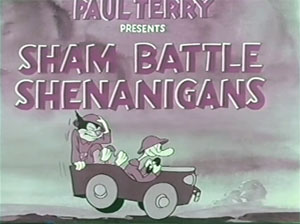 Sham Battle Shenanigans (Terrytoons/Fox, Gandy Goose, 3/20/42 – Connie Rasinski, dir.) is a piece of utter nonsense – told to the civilian audience by Private Gandy Goose, reporting from the front on the Dunker’s Donuts radio show. Gandy and his sergeant Sourpuss are out on war game maneuvers, where everything seems to be a fake. Armies are identified by signs on trees, indicating the number of men they represent. Gandy and Sourpuss ride in a jeep, with their own sign reading “5,000 men.” They drive under a low tree limb, which knocks away part of their sign, so that it now reads “0 men.” They do battle with the tree that took away their platoon, firing machine gun fire into a hole in the trunk. The bullets curve around inside the hollow tree and shoot out of the limb, peppering Sourpuss. He commands Gandy to fire at where the shots are coming from – which accomplishes nothing but to pit the bullets through the same curve in reverse, emerging from the trunk to pepper Sourpuss again. They retreat across a bridge, which Sourpuss commands they must blow up. “Gimme the dynamite”, he instructs. “What dynamite?”, shrugs Gandy. Using his imagination, Sourpuss plays pretend, grabbing at the air above Gandy’s hand as as if he has just taken an invisible dynamite stick from the private. “Light it”, he commands again. Going along with the gag, Gandy pulls out a match, and holds it as if lighting an invisible fuse. Sourpuss goes through the motions of a pitch toward the bridge, then he and Gandy cover their ears. “Boom”, shouts Sourpuss – but suddenly, there is a much louder boom – from a real explosion. The bridge disappears. A puzzled Sourpuss tells Gandy, “There’s something screwy about this.” Another explosion jolts them, leaving a crater only a few feet behind them. It seems the war games have escalated to the use of live ammunition, and real weapons. A real plane soars overhead, though still relying on fakes for its passengers, as it drops a stream ofd paratroopers toward our heroes – all of them consisting of dressmaker’s dummies. Gandy and Sourpuss flee, until Sourpuss notices the wheeled base of a dummy pursuing them, and asks his partner, “What are you running for?” “It’s my Aunt Mary”, responds Gandy (who must “hate relatives” as much as Poopdeck Pappy). The two soldiers stop in their tracks and reverser their retreat, as real tanks emerge, firing shells. From a tree, a machine gun opens fire from a machine gun “nest”. Another plane swoops over them, and drops an aerial bomb. There is no escape, and nowhere to run. An explosion engulfs the screen, and when the smoke clears, Gandy and Sourpuss are riding an artillery shell, whizzing through the air. “What do we do now?”, Gandy asks his pal. We never learn the answer, as Gandy’s tale is interrupted by a singing commercial by a trio of live donuts, encouraging everyone to eat the sponsor’s product. Gandy takes the hint, and instead of providing us with an ending, is seen chomping on donuts and dunking them into a coffee cup, as he bids the audience, “Good Night”.
Sham Battle Shenanigans (Terrytoons/Fox, Gandy Goose, 3/20/42 – Connie Rasinski, dir.) is a piece of utter nonsense – told to the civilian audience by Private Gandy Goose, reporting from the front on the Dunker’s Donuts radio show. Gandy and his sergeant Sourpuss are out on war game maneuvers, where everything seems to be a fake. Armies are identified by signs on trees, indicating the number of men they represent. Gandy and Sourpuss ride in a jeep, with their own sign reading “5,000 men.” They drive under a low tree limb, which knocks away part of their sign, so that it now reads “0 men.” They do battle with the tree that took away their platoon, firing machine gun fire into a hole in the trunk. The bullets curve around inside the hollow tree and shoot out of the limb, peppering Sourpuss. He commands Gandy to fire at where the shots are coming from – which accomplishes nothing but to pit the bullets through the same curve in reverse, emerging from the trunk to pepper Sourpuss again. They retreat across a bridge, which Sourpuss commands they must blow up. “Gimme the dynamite”, he instructs. “What dynamite?”, shrugs Gandy. Using his imagination, Sourpuss plays pretend, grabbing at the air above Gandy’s hand as as if he has just taken an invisible dynamite stick from the private. “Light it”, he commands again. Going along with the gag, Gandy pulls out a match, and holds it as if lighting an invisible fuse. Sourpuss goes through the motions of a pitch toward the bridge, then he and Gandy cover their ears. “Boom”, shouts Sourpuss – but suddenly, there is a much louder boom – from a real explosion. The bridge disappears. A puzzled Sourpuss tells Gandy, “There’s something screwy about this.” Another explosion jolts them, leaving a crater only a few feet behind them. It seems the war games have escalated to the use of live ammunition, and real weapons. A real plane soars overhead, though still relying on fakes for its passengers, as it drops a stream ofd paratroopers toward our heroes – all of them consisting of dressmaker’s dummies. Gandy and Sourpuss flee, until Sourpuss notices the wheeled base of a dummy pursuing them, and asks his partner, “What are you running for?” “It’s my Aunt Mary”, responds Gandy (who must “hate relatives” as much as Poopdeck Pappy). The two soldiers stop in their tracks and reverser their retreat, as real tanks emerge, firing shells. From a tree, a machine gun opens fire from a machine gun “nest”. Another plane swoops over them, and drops an aerial bomb. There is no escape, and nowhere to run. An explosion engulfs the screen, and when the smoke clears, Gandy and Sourpuss are riding an artillery shell, whizzing through the air. “What do we do now?”, Gandy asks his pal. We never learn the answer, as Gandy’s tale is interrupted by a singing commercial by a trio of live donuts, encouraging everyone to eat the sponsor’s product. Gandy takes the hint, and instead of providing us with an ending, is seen chomping on donuts and dunking them into a coffee cup, as he bids the audience, “Good Night”.
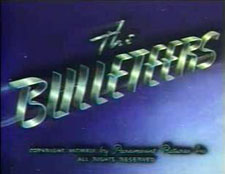 The Bulleteers (Fleischer/Paramount, Superman, 3/26/42 – Dave Fleischer, dir., Orestes Calpini/Graham Place, anim.) – A new terror hits Metropolis – literally, as a mysterious vehicle zooms through the sky so fast as to be nearly invisible as it passes, leaving a gaping hole blasted through the walls of police headquarters. The structure is destroyed, as the perpetrators disappear into the blue. Next day, a public address system planted in the hills surrounding the city booms a message to the mayor, to surrender the city treasury, or municipal buildings and power plants will be next. Details, as we will see, are rather unimportant to the creators of this cartoon, as (1) no explanation is provided as to how a public address system could be built so powerful as to be heard without the aid of radio all over town; (2) no one seems to be able to trace its source; and (3) no instructions are given as to how to deliver the ransom, ensuring that it will never be paid. The vehicle that has caused this mess is a fully streamlined, bullet-shaped car that doubles as a plane by sprouting wings once attaining flight speed. More details are skipped over in the design of the car, as wing holes, and the seam where the cockpit roof meets up with the windshield, regularly disappear entirely from view whenever the wings are retracted or the cockpit is closed, not even leaving an outline for a seam. A further strange design flaw is the inclusion of a nose headlight in the car’s conical “head”, which emits a beam of light on where the vehicle will strike an oncoming target. But what possible substance can this headlight be made of, to withstand the force of the vehicle’s impacts upon buildings? It needs to be clear to emit light, but obviously glass won’t do, and plastics weren’t yet in ready use or anywhere near that durable. Diamond? If the “bulleteers”, as the gang owning the car come to be called, have enough funds to buy a diamond that size, they don’t need to resort to crime. Not to mention that the facets of diamonds would likely result in the gem surface being “cut” by each impact, shattering the lens regardless of the hardness of the element itself. Like I said, details aren’t important.
The Bulleteers (Fleischer/Paramount, Superman, 3/26/42 – Dave Fleischer, dir., Orestes Calpini/Graham Place, anim.) – A new terror hits Metropolis – literally, as a mysterious vehicle zooms through the sky so fast as to be nearly invisible as it passes, leaving a gaping hole blasted through the walls of police headquarters. The structure is destroyed, as the perpetrators disappear into the blue. Next day, a public address system planted in the hills surrounding the city booms a message to the mayor, to surrender the city treasury, or municipal buildings and power plants will be next. Details, as we will see, are rather unimportant to the creators of this cartoon, as (1) no explanation is provided as to how a public address system could be built so powerful as to be heard without the aid of radio all over town; (2) no one seems to be able to trace its source; and (3) no instructions are given as to how to deliver the ransom, ensuring that it will never be paid. The vehicle that has caused this mess is a fully streamlined, bullet-shaped car that doubles as a plane by sprouting wings once attaining flight speed. More details are skipped over in the design of the car, as wing holes, and the seam where the cockpit roof meets up with the windshield, regularly disappear entirely from view whenever the wings are retracted or the cockpit is closed, not even leaving an outline for a seam. A further strange design flaw is the inclusion of a nose headlight in the car’s conical “head”, which emits a beam of light on where the vehicle will strike an oncoming target. But what possible substance can this headlight be made of, to withstand the force of the vehicle’s impacts upon buildings? It needs to be clear to emit light, but obviously glass won’t do, and plastics weren’t yet in ready use or anywhere near that durable. Diamond? If the “bulleteers”, as the gang owning the car come to be called, have enough funds to buy a diamond that size, they don’t need to resort to crime. Not to mention that the facets of diamonds would likely result in the gem surface being “cut” by each impact, shattering the lens regardless of the hardness of the element itself. Like I said, details aren’t important.
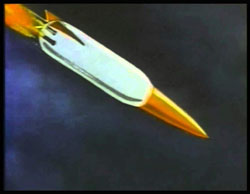 The mayor of course won’t knuckle under to the mob’s threats, and fortifies his civic buildings with barricades, troops, and machine gun nests. As the mob reads about these activities from Lois’s latest headline in the Daily Planet, they ready the car for another strike. Hurtling down the highway, then spreading its wings, the car-plane soars over the first row of barricades. Gaining elevation, it changes direction to tilt downward, executing a power dive, as the wings are retracted back inside. The light beam zeroes in upon a power plant, and destroys its dynamo, darkening the city, stopping electric railway cars, and shutting down the presses at the Daily Planet. Lois leaps into her car to find the story behind it, leaving Clark Kent standing on the curb without a ride. Clark just smiles a knowing smile at Lois’s typical behavior, and waves her an unseen wave so-long, before disappearing into a telephone booth to handle “a job for Superman.” Watch for a cool animation error when he emerges from the booth, as the S on his chest for no explainable reason reverses to a mirror image for a couple of frames! As the vehicle in plane mode swoops at another building, Superman stands in the path of the headlight beam, and gives the vehicle a sock with a right cross. (Popeye would have recommended a twisker punch.) Instead of being destroyed, the plane just changes course in an immediate right angle, performing a large loop around the town. It passes so close to Lois’s car that her vehicle is buried in rubble drawn along in the wake of the passing jet stream, causing Superman to take a time out to drag Lois and the car out of the debris. Superman flies and catches up with the plane, hanging onto the nose light, and trying to drag the plane downward. But the hoodlums aim the plane at the city treasury building, and crash into it with Superman still on the nose. Our hero is buried in the building’s remains, as Lois somehow catches up to the action. (Even the cars must be impossibly durable, surviving a burial and still coming out running.) Lois scrambles over the panels of fallen concrete, to find the crooks and their car within the lower floors of the building’s remains, the villains leaving their car momentarily, presumably to enter the vaults and nab the treasury money. Interesting that in all prior instances, the bullet plane roared right through and past the buildings it hit – but now the craft can somehow stop on a dime. More detail is omitted, as we never see whether the crooks find the money. Instead, we watch Lois enter the cockpit of the plane, and begin smashing at its instrument panel in an attempt to disable it. The crooks return, and, though Lois tries to climb out, they close the cockpit and take Lois along “for a ride”. Meanwhile concrete slabs and girders outside begin to move, as Superman rises again. As the plane gains altitude, Superman grabs hold of one of the wing tips, and starts to bend it as if rolling up a tube of toothpaste. With no regard for the metal warping, the villains are able to merely push the retract button, and the wings fold back into the body neatly, making no metal-to-metal contact or friction whatsoever in the process. Now really, why isn’t one wing hopelessly jammed outside the plane, to throw the craft off balance? Superman is swept back to the tail of the plane as the craft becomes streamlined again, but grabs hold of the rocket-like tail fins of the craft, flying in a circle to put the plane Into a spin. He then climbs back to the cockpit, opening its roof as if it were one of Popeye’s spinach cans. He grabs Lois in one arm, and the three hoods in the other, and takes off, leaving the plane to crash below. (What else got destroyed n the process?) We also hope the crooks didn’t get any of the treasury loot, or else it must have burned up in flames when the plane went down. Lois as usual gets her story, thanks to Superman.
The mayor of course won’t knuckle under to the mob’s threats, and fortifies his civic buildings with barricades, troops, and machine gun nests. As the mob reads about these activities from Lois’s latest headline in the Daily Planet, they ready the car for another strike. Hurtling down the highway, then spreading its wings, the car-plane soars over the first row of barricades. Gaining elevation, it changes direction to tilt downward, executing a power dive, as the wings are retracted back inside. The light beam zeroes in upon a power plant, and destroys its dynamo, darkening the city, stopping electric railway cars, and shutting down the presses at the Daily Planet. Lois leaps into her car to find the story behind it, leaving Clark Kent standing on the curb without a ride. Clark just smiles a knowing smile at Lois’s typical behavior, and waves her an unseen wave so-long, before disappearing into a telephone booth to handle “a job for Superman.” Watch for a cool animation error when he emerges from the booth, as the S on his chest for no explainable reason reverses to a mirror image for a couple of frames! As the vehicle in plane mode swoops at another building, Superman stands in the path of the headlight beam, and gives the vehicle a sock with a right cross. (Popeye would have recommended a twisker punch.) Instead of being destroyed, the plane just changes course in an immediate right angle, performing a large loop around the town. It passes so close to Lois’s car that her vehicle is buried in rubble drawn along in the wake of the passing jet stream, causing Superman to take a time out to drag Lois and the car out of the debris. Superman flies and catches up with the plane, hanging onto the nose light, and trying to drag the plane downward. But the hoodlums aim the plane at the city treasury building, and crash into it with Superman still on the nose. Our hero is buried in the building’s remains, as Lois somehow catches up to the action. (Even the cars must be impossibly durable, surviving a burial and still coming out running.) Lois scrambles over the panels of fallen concrete, to find the crooks and their car within the lower floors of the building’s remains, the villains leaving their car momentarily, presumably to enter the vaults and nab the treasury money. Interesting that in all prior instances, the bullet plane roared right through and past the buildings it hit – but now the craft can somehow stop on a dime. More detail is omitted, as we never see whether the crooks find the money. Instead, we watch Lois enter the cockpit of the plane, and begin smashing at its instrument panel in an attempt to disable it. The crooks return, and, though Lois tries to climb out, they close the cockpit and take Lois along “for a ride”. Meanwhile concrete slabs and girders outside begin to move, as Superman rises again. As the plane gains altitude, Superman grabs hold of one of the wing tips, and starts to bend it as if rolling up a tube of toothpaste. With no regard for the metal warping, the villains are able to merely push the retract button, and the wings fold back into the body neatly, making no metal-to-metal contact or friction whatsoever in the process. Now really, why isn’t one wing hopelessly jammed outside the plane, to throw the craft off balance? Superman is swept back to the tail of the plane as the craft becomes streamlined again, but grabs hold of the rocket-like tail fins of the craft, flying in a circle to put the plane Into a spin. He then climbs back to the cockpit, opening its roof as if it were one of Popeye’s spinach cans. He grabs Lois in one arm, and the three hoods in the other, and takes off, leaving the plane to crash below. (What else got destroyed n the process?) We also hope the crooks didn’t get any of the treasury loot, or else it must have burned up in flames when the plane went down. Lois as usual gets her story, thanks to Superman.
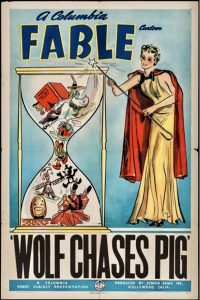 Wolf Chases Pigs (Columbia/Screen Gems, Fable, 4/20/42 – Frank Tashlin/Bob Wickersham, dir.) – There was some marked improvement in the output of the Columbia studios starting in 1940, when Frank Tashlin was placed in position of supervisor of the animation division. While the studio’s product was already beginning to mirror the style of Warner Brothers in low-budget form, Tashlin’s influence as an actual former resident of Termite Terrace made the resemblance to his former product even more apparent, plus resulted in the brief availability of increased budgets, presumably insisted upon by Tashlin. The changes for the better show on the screen, and Frank himself couldn’t resist putting his own personal touch in by directing several key projects. One of his first innovations was to begin a series of fairytale spoofs in broad lampoon style, among his earliest being the landmark “Fox and the Grapes” that would introduce the studio’s strongest characters during the 1940’s – the Fox and Crow. Another of his better directorial efforts was the film we are about to review, although made less expensively in black and white. Just to be different, Tashlin integrates the series title and animation credits into the middle of a chase between the three little pigs and the big bad wolf, with the wolf actually bumping his head upon the sign reading “A Fable Cartoon”. (We can only be thankful that Columbia was not prone to reissue its black and white cartoons as “A Columbia Favorite”, or this footage might have wound up in the wastebasket, replaced by a static reissue card, as regrettably occurred to the integrated opening titles of the Color Rhapsody “Concerto in B Flat Minor”, delaying the start of any animation by about 45 seconds! The wolf continues the pursuit, but the pugs split up at the crossroads, and the wolf loses track of them. “Suey! Suey!” he calls out (in the usual booming tones of Billy Bletcher). But the pigs are nowhere to be found, as on-screen superimposed lettering depicts the wolf’s search through wintery blasts (disguised as Santa Claus) and through the spring (dressed as an Easter bunny). The screen lettering finally states, “They’re in the Army now”, which the wolf merely reads off the screen to get the hint. Racing for his local recruiting station, the wolf signs up for a one year hitch, asking to be assigned to the same unit as his “old friends”, the pigs. His request is granted, but the recruiting officer comments that “They’re sergeants now.”
Wolf Chases Pigs (Columbia/Screen Gems, Fable, 4/20/42 – Frank Tashlin/Bob Wickersham, dir.) – There was some marked improvement in the output of the Columbia studios starting in 1940, when Frank Tashlin was placed in position of supervisor of the animation division. While the studio’s product was already beginning to mirror the style of Warner Brothers in low-budget form, Tashlin’s influence as an actual former resident of Termite Terrace made the resemblance to his former product even more apparent, plus resulted in the brief availability of increased budgets, presumably insisted upon by Tashlin. The changes for the better show on the screen, and Frank himself couldn’t resist putting his own personal touch in by directing several key projects. One of his first innovations was to begin a series of fairytale spoofs in broad lampoon style, among his earliest being the landmark “Fox and the Grapes” that would introduce the studio’s strongest characters during the 1940’s – the Fox and Crow. Another of his better directorial efforts was the film we are about to review, although made less expensively in black and white. Just to be different, Tashlin integrates the series title and animation credits into the middle of a chase between the three little pigs and the big bad wolf, with the wolf actually bumping his head upon the sign reading “A Fable Cartoon”. (We can only be thankful that Columbia was not prone to reissue its black and white cartoons as “A Columbia Favorite”, or this footage might have wound up in the wastebasket, replaced by a static reissue card, as regrettably occurred to the integrated opening titles of the Color Rhapsody “Concerto in B Flat Minor”, delaying the start of any animation by about 45 seconds! The wolf continues the pursuit, but the pugs split up at the crossroads, and the wolf loses track of them. “Suey! Suey!” he calls out (in the usual booming tones of Billy Bletcher). But the pigs are nowhere to be found, as on-screen superimposed lettering depicts the wolf’s search through wintery blasts (disguised as Santa Claus) and through the spring (dressed as an Easter bunny). The screen lettering finally states, “They’re in the Army now”, which the wolf merely reads off the screen to get the hint. Racing for his local recruiting station, the wolf signs up for a one year hitch, asking to be assigned to the same unit as his “old friends”, the pigs. His request is granted, but the recruiting officer comments that “They’re sergeants now.”
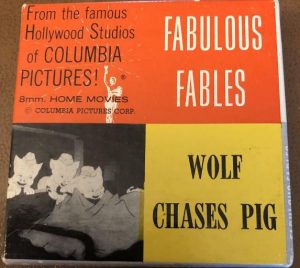 Realization dawns on the wolf that this may not be so good, and he attempts to back out of the office. Right behind him stand the trio of new sergeants, who, having the wolf at their mercy, set out to put him through proverbial Hades. A 100 mile hike is in order, with a backpack stacked a block long behind him. When the wolf collapses, he begs, “Okay, you win. Please don’t make me walk back. Me feet are killin’ me.” The pigs oblige, telling the wolf he can ride. The ride is aboard a charging cavalry horse, leaving the wolf with saddle sores to match his aching bunions. No sooner does he hit his bunk, than the pigs are blowing reveille over his bed, accusing him of oversleeping, and assigning him to K.P. As the wolf reaches his 9,900,900,001st peeled potato, he gripes, “They’re wearin’ me down. They’re ruinin’ me morale,” Carving a potato into the shape of a pig head, the wolf vows, “Army or no army, I’ll tear ‘em ham from bacon!” The next morning, the wolf produces a machine gun from the camp arsenal, and zeroes in its sights on the pigs, envisioning them as smoking hams. He opens fire, but his leg catches in the ammunition belt, dragging it inside the gun barrel. With the gun now mounted on his leg, one step produces the effect of being bounced around like a pogo stick, while bullets fly in all directions. The gun aims skyward, sending a line of bullets through the length of the fuselage of a passing bomber, sawing the plane in two. A bullet explodes the huge tire of a B-19 while it is being inflated by a crewman with a bicycle pump – leaving the crewman blown backwards into the shaft of the pump, with the handle on his head. The gunfire blasts a bugle out of the mouth of the bugler, blows away a tank to leave only its advancing treads, then the runaway gun bounces the wolf straight for the ammunition dump. The wolf screams in helpless panic, sensing his oblivion is at hand, as the shed explodes, blasting the wolf into the sky. A camera pan upwards reveals another plane overhead, with a wolf-shaped hole through its forward fuselage. A cutaway view reveals the wolf inside the huge engine of the aircraft, being systematically compressed and squirted with oil by the engine’s massive cylinders. A fade out, while an announcer states, “Time marches on.” Army discipline finally makes a new man out of the wolf, seemingly reformed, as his tour of duty runs out, and the pigs escort him to the gate for his return to civilian life. While the wolf thanks them for showing him the error of his ways, he observes that the pigs are dressed in street clothes. “Hey, are you fellas out of the army, too?” “Um hmm”, the pigs nod. That’s all the cue the wolf needs – and reverts back to form, as the pigs run for the hills, while the wolf pauses to tell the audience, “Can I help it if I love pork?”
Realization dawns on the wolf that this may not be so good, and he attempts to back out of the office. Right behind him stand the trio of new sergeants, who, having the wolf at their mercy, set out to put him through proverbial Hades. A 100 mile hike is in order, with a backpack stacked a block long behind him. When the wolf collapses, he begs, “Okay, you win. Please don’t make me walk back. Me feet are killin’ me.” The pigs oblige, telling the wolf he can ride. The ride is aboard a charging cavalry horse, leaving the wolf with saddle sores to match his aching bunions. No sooner does he hit his bunk, than the pigs are blowing reveille over his bed, accusing him of oversleeping, and assigning him to K.P. As the wolf reaches his 9,900,900,001st peeled potato, he gripes, “They’re wearin’ me down. They’re ruinin’ me morale,” Carving a potato into the shape of a pig head, the wolf vows, “Army or no army, I’ll tear ‘em ham from bacon!” The next morning, the wolf produces a machine gun from the camp arsenal, and zeroes in its sights on the pigs, envisioning them as smoking hams. He opens fire, but his leg catches in the ammunition belt, dragging it inside the gun barrel. With the gun now mounted on his leg, one step produces the effect of being bounced around like a pogo stick, while bullets fly in all directions. The gun aims skyward, sending a line of bullets through the length of the fuselage of a passing bomber, sawing the plane in two. A bullet explodes the huge tire of a B-19 while it is being inflated by a crewman with a bicycle pump – leaving the crewman blown backwards into the shaft of the pump, with the handle on his head. The gunfire blasts a bugle out of the mouth of the bugler, blows away a tank to leave only its advancing treads, then the runaway gun bounces the wolf straight for the ammunition dump. The wolf screams in helpless panic, sensing his oblivion is at hand, as the shed explodes, blasting the wolf into the sky. A camera pan upwards reveals another plane overhead, with a wolf-shaped hole through its forward fuselage. A cutaway view reveals the wolf inside the huge engine of the aircraft, being systematically compressed and squirted with oil by the engine’s massive cylinders. A fade out, while an announcer states, “Time marches on.” Army discipline finally makes a new man out of the wolf, seemingly reformed, as his tour of duty runs out, and the pigs escort him to the gate for his return to civilian life. While the wolf thanks them for showing him the error of his ways, he observes that the pigs are dressed in street clothes. “Hey, are you fellas out of the army, too?” “Um hmm”, the pigs nod. That’s all the cue the wolf needs – and reverts back to form, as the pigs run for the hills, while the wolf pauses to tell the audience, “Can I help it if I love pork?”
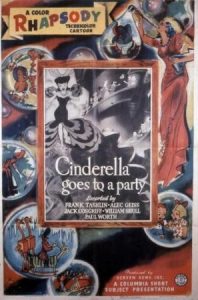 Cinderella Goes To a Party (Columbia/Screen Gems, Color Rhapsody, 6/3/42 – Alec Geiss, dir.) – Another twisted fairytale, under the Warner-esque oversight of Frank Tashlin’s short stint in charge. The title refers to a feature magazine article from a Match 1938 edition of Life Magazine entitled “Life Goes To a Party” which attained some notoriety as a catch-phrase of the day (Benny Goodman would even record a song using the title). The film opens on the silhouettes behind a curtain of Cinderella’s ugly stepsisters, who talk like the man-crazy Brenda and Cobina characters portrayed by Blanche Stewart and Elvia Allman on Bob Hope’s Pepsodent radio show. They slip into something less comfortable in preparation for the ball, which temporarily makes their figures look like dream dolls, until a clatter offscreen jolts them out of their reverie. “Cinderella!”, they scold, as poor Cindy has dropped a pile of pots and pans she is cleaning. As Cindy cries, she attempts to polish what she believes is a pan, but is actually the bottom of an old oil lamp. Out rises a huge stereotypical black form – the genie with the light brown hair. He quickly realizes he is in the wrong story, and tells Cindy what she needs is a fairy godmother. In the manner of a Phillip Morris cigarette commercial, he shouts “Call for Fairy Godmother.” Making reference to Stephen Foster’s “Old Black Joe”, the godmother’s voice replies “I’m comin’. I’m, comin’”, while the genie musically concludes the line with “And now I have to go.” The godmother crash lands on a broomstick, having gained an extra few pounds recently. She announces herself as a union member of Local 222 of the AFL – American Fairies Local. Declaring that Cindy is going to the royal jam session, a wave of her wand soon has Cindy dressed in finery – complete with two silkworms that knit Cindy a custom pair of nylons while she waits. Four mice carry in a pumpkin, singing a happy song about going to a party, but the godmother dismisses them as old hat, saying “Go away, boys, ya bother me.” Instead, she begins muttering a magic incantation, including the words “Mumbo jumbo priorities”, which summons every spare pot, pan, or other metal object in the house together, to cluster and blend into the form of a “super plane”. The resulting vehicle is so big, it explodes Cindy’s cottage from its sheer size (we hope the godmother is a licensed contractor to build Cindy a new home on the return trip), and the wings of the plane, a four engine bomber, sprout the lettering, “B-19 1/2″. As Cindy takes off, the godmother flies by the cockpit on her broom, with a last-minute reminder to be home by midnight – then accidentally flies straight into a steeple bell tower.
Cinderella Goes To a Party (Columbia/Screen Gems, Color Rhapsody, 6/3/42 – Alec Geiss, dir.) – Another twisted fairytale, under the Warner-esque oversight of Frank Tashlin’s short stint in charge. The title refers to a feature magazine article from a Match 1938 edition of Life Magazine entitled “Life Goes To a Party” which attained some notoriety as a catch-phrase of the day (Benny Goodman would even record a song using the title). The film opens on the silhouettes behind a curtain of Cinderella’s ugly stepsisters, who talk like the man-crazy Brenda and Cobina characters portrayed by Blanche Stewart and Elvia Allman on Bob Hope’s Pepsodent radio show. They slip into something less comfortable in preparation for the ball, which temporarily makes their figures look like dream dolls, until a clatter offscreen jolts them out of their reverie. “Cinderella!”, they scold, as poor Cindy has dropped a pile of pots and pans she is cleaning. As Cindy cries, she attempts to polish what she believes is a pan, but is actually the bottom of an old oil lamp. Out rises a huge stereotypical black form – the genie with the light brown hair. He quickly realizes he is in the wrong story, and tells Cindy what she needs is a fairy godmother. In the manner of a Phillip Morris cigarette commercial, he shouts “Call for Fairy Godmother.” Making reference to Stephen Foster’s “Old Black Joe”, the godmother’s voice replies “I’m comin’. I’m, comin’”, while the genie musically concludes the line with “And now I have to go.” The godmother crash lands on a broomstick, having gained an extra few pounds recently. She announces herself as a union member of Local 222 of the AFL – American Fairies Local. Declaring that Cindy is going to the royal jam session, a wave of her wand soon has Cindy dressed in finery – complete with two silkworms that knit Cindy a custom pair of nylons while she waits. Four mice carry in a pumpkin, singing a happy song about going to a party, but the godmother dismisses them as old hat, saying “Go away, boys, ya bother me.” Instead, she begins muttering a magic incantation, including the words “Mumbo jumbo priorities”, which summons every spare pot, pan, or other metal object in the house together, to cluster and blend into the form of a “super plane”. The resulting vehicle is so big, it explodes Cindy’s cottage from its sheer size (we hope the godmother is a licensed contractor to build Cindy a new home on the return trip), and the wings of the plane, a four engine bomber, sprout the lettering, “B-19 1/2″. As Cindy takes off, the godmother flies by the cockpit on her broom, with a last-minute reminder to be home by midnight – then accidentally flies straight into a steeple bell tower.
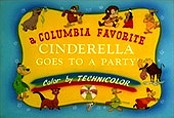 The palace is illuminated by multicolor Hollywood searchlights, and a neon sign announces “Prince Charming’s U.S.O. Party – Hot Music – Frozen Prices”. Cindy’s plane lands, and a series of footmen of progressive height bow before the door of the plane, forming a human staircase for Cindy to step to the ground. A herald’s trumpet announces the prince, who looks and sounds like Jerry Colonna. Introducing himself to the lovely Cindy, the prince asks her to pardon him for a minute while he commands the band to play. The prince walks to a huge machine labeled “Ye Royal Juke Box”, turns a selector knob, and drops a coin in. High atop the machine, a huge disc is seated on a turntable, on top of which performs a live string quartet. The mechanical arm of an automatic record changer lifts quartet and disc off the turntable and jettisons them, lifting in instead a new giant disc atop which performs a conga band. On the dance floor, Cindy and the prince sway in sideways steps back and forth to the conga rhythm, while the prince, in Colonna fashion, comments, “Monotonous, isn’t it.” Soon, a conga line of all the others at the ball is following behind them, while the searchlights, and even the clock on the wall, move in conga rhythm, toward the approach of midnight. Just as the prince makes his move to try for a kiss, the clock strikes midnight. Cindy makes a hasty escape, and the prince, leaping for her, is only able to catch one of her slippers. Cindy boards her plane for the return ride, but doesn’t quite make it, as her craft returns to the form of random pots and pans. Cindy’s skirt slows her fall as a sort of parachute, and she is caught on the end of the broomstick of the fairy godmother, who reminds her that she was warned. “After all, these pots are on the priorities list.”
The palace is illuminated by multicolor Hollywood searchlights, and a neon sign announces “Prince Charming’s U.S.O. Party – Hot Music – Frozen Prices”. Cindy’s plane lands, and a series of footmen of progressive height bow before the door of the plane, forming a human staircase for Cindy to step to the ground. A herald’s trumpet announces the prince, who looks and sounds like Jerry Colonna. Introducing himself to the lovely Cindy, the prince asks her to pardon him for a minute while he commands the band to play. The prince walks to a huge machine labeled “Ye Royal Juke Box”, turns a selector knob, and drops a coin in. High atop the machine, a huge disc is seated on a turntable, on top of which performs a live string quartet. The mechanical arm of an automatic record changer lifts quartet and disc off the turntable and jettisons them, lifting in instead a new giant disc atop which performs a conga band. On the dance floor, Cindy and the prince sway in sideways steps back and forth to the conga rhythm, while the prince, in Colonna fashion, comments, “Monotonous, isn’t it.” Soon, a conga line of all the others at the ball is following behind them, while the searchlights, and even the clock on the wall, move in conga rhythm, toward the approach of midnight. Just as the prince makes his move to try for a kiss, the clock strikes midnight. Cindy makes a hasty escape, and the prince, leaping for her, is only able to catch one of her slippers. Cindy boards her plane for the return ride, but doesn’t quite make it, as her craft returns to the form of random pots and pans. Cindy’s skirt slows her fall as a sort of parachute, and she is caught on the end of the broomstick of the fairy godmother, who reminds her that she was warned. “After all, these pots are on the priorities list.”
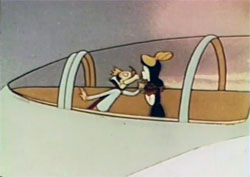 An Extra rolls off the local presses – “Prince Left in Lurch. Starts Frantic Search. Fnds Love at Ball – Bawls for Love.” A second paper announces a reward offered of $10,000 in war bonds. The cover of Strife magazine shows a photo of the slipper, worn by a giant question mark, accompanied by a feature story, “Strife Goes On a Searching Party”, illustrating the slipper being tried upon Eskimos, Hawaiians, and Egyptians, among others. Suddenly, a new Extra announces that Cindy is found, riveting tail assemblies at Lockheed. The final shot depicts a string of tin cans tied by ribbons to a “Just Married” sign, being towed through the sky behind Cindy’s super plane. Inside the cockpit, Cindy and the price embrace, but the plane’s wings start to return to the form of pots and pans again. “Not tonight, fairy godmother, not tonight”, shouts the prince to the heavens. The wings revert back to solid form, prompting a “Thank you” from the prince. The camera pans back to the plane’s tail, where the disgruntled mice have ensured themselves a part in the story after all, having carved their pumpkin into the form of a cradle, in expectation of the inevitable, as the cast flies off into the sunset toward their happy ending.
An Extra rolls off the local presses – “Prince Left in Lurch. Starts Frantic Search. Fnds Love at Ball – Bawls for Love.” A second paper announces a reward offered of $10,000 in war bonds. The cover of Strife magazine shows a photo of the slipper, worn by a giant question mark, accompanied by a feature story, “Strife Goes On a Searching Party”, illustrating the slipper being tried upon Eskimos, Hawaiians, and Egyptians, among others. Suddenly, a new Extra announces that Cindy is found, riveting tail assemblies at Lockheed. The final shot depicts a string of tin cans tied by ribbons to a “Just Married” sign, being towed through the sky behind Cindy’s super plane. Inside the cockpit, Cindy and the price embrace, but the plane’s wings start to return to the form of pots and pans again. “Not tonight, fairy godmother, not tonight”, shouts the prince to the heavens. The wings revert back to solid form, prompting a “Thank you” from the prince. The camera pans back to the plane’s tail, where the disgruntled mice have ensured themselves a part in the story after all, having carved their pumpkin into the form of a cradle, in expectation of the inevitable, as the cast flies off into the sunset toward their happy ending.
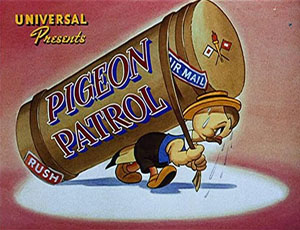 Pigeon Patrol (Lantz/Universal, 6/3/42 – Alex Lovy, dir.) – The introduction of a character who would have a longer life in print than on the screen – Homer Pigeon, a sound-alike to Red Skelton’s “Clem Kadiddlehopper” hick character. Homer brings flowers to his girl, but finds her eyes glued to the skies, as she watches a squad of Army carrier pigeons soar overhead, their wings somehow generating the sounds of airplane motors. “What’ve they got that I haven’t got?”, asks Homer. “Wouldn’t you like to know?” replies his girl, closing the door to him. Homer decides to enlist and become the best carrier pigeon there ever was, but upon arriving at the recruiting office, notes the inducting officer measuring the applicants for broadness of chest, accepting those with abdomens four times the size of his own puny physique (which he can barely make larger by his deepest inhale). About to give up his dream as a futility, Homer spots a box of weather balloons in the next room. Placing an uninflated one into his throat, Homer uses a helium tank to inflate the balloon inside him. The officer suspects something when he puts a tape measure around Homer, and it compresses Homer’s abdomen to make him look like an hourglass. Homer opens his mouth to speak, and the air valve of the balloon utters an unexpected raspberry. As Homer turns several colors trying to hold the air within him, the sergeant takes a pointed fountain pen from his desk, and jabs at Homer’s rear end, puncturing the balloon. Homer is soon dismissed out the door, and slowly trudges back toward home in dejection. A commotion above draws his attentions to the sky. A carrier pigeon is in trouble, being pursued by a huge hawk with misshapen teeth and slanting eyes – of stereotypical Japanese nationality. The hawk bites away the tail plumage of the carrier, causing him to lose steering power, and crash to the ground.
Pigeon Patrol (Lantz/Universal, 6/3/42 – Alex Lovy, dir.) – The introduction of a character who would have a longer life in print than on the screen – Homer Pigeon, a sound-alike to Red Skelton’s “Clem Kadiddlehopper” hick character. Homer brings flowers to his girl, but finds her eyes glued to the skies, as she watches a squad of Army carrier pigeons soar overhead, their wings somehow generating the sounds of airplane motors. “What’ve they got that I haven’t got?”, asks Homer. “Wouldn’t you like to know?” replies his girl, closing the door to him. Homer decides to enlist and become the best carrier pigeon there ever was, but upon arriving at the recruiting office, notes the inducting officer measuring the applicants for broadness of chest, accepting those with abdomens four times the size of his own puny physique (which he can barely make larger by his deepest inhale). About to give up his dream as a futility, Homer spots a box of weather balloons in the next room. Placing an uninflated one into his throat, Homer uses a helium tank to inflate the balloon inside him. The officer suspects something when he puts a tape measure around Homer, and it compresses Homer’s abdomen to make him look like an hourglass. Homer opens his mouth to speak, and the air valve of the balloon utters an unexpected raspberry. As Homer turns several colors trying to hold the air within him, the sergeant takes a pointed fountain pen from his desk, and jabs at Homer’s rear end, puncturing the balloon. Homer is soon dismissed out the door, and slowly trudges back toward home in dejection. A commotion above draws his attentions to the sky. A carrier pigeon is in trouble, being pursued by a huge hawk with misshapen teeth and slanting eyes – of stereotypical Japanese nationality. The hawk bites away the tail plumage of the carrier, causing him to lose steering power, and crash to the ground.
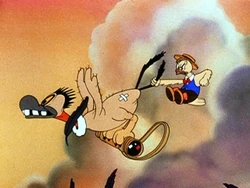 On the ground lays the pouch holding the carrier’s message, while the flyer sits in a daze a few feet away. “Gosh, are ya hurt?”, asks Homer. “Don’t worry about me”, says the brave flyer. “That message must get through. It means life or death!” Patriotic Homer volunteers to complete the flyer’s mission – but he can barely lift the message pouch. He accomplishes gaining altitude fast by diving into an old toaster in a nearby junkyard, the springs of which pop him into the air in a hurry. But once airborne, he quickly encounters the enemy hawk, waiting in front of him. The hawk tries to put the bite again on Homer’s tail, but Homer outmaneuvers him by slamming on his “air” brakes, letting the hawk pass, to smack headfirst into a church bell in a steeple, leaving an indentation in the shape of his head in the bell’s side. As Homer races away, his old straw hat, which he wears with an elastic cord attached to it to prevent it from blowing away, trails behind him. The hawk grabs the hat in one of his claws, letting Homer run until he has reached the limit of the cord’s elasticity, then lets loose of the hat. The snapping impact loosens the mail pouch from Homer’s back, and the hawk swoops in, taking the message in his claws. Homer’s temper rises, and, gritting his teeth, he soars upwards after the enemy bird, in the process transforming on the screen into the image of a twin-fuselage P-38 Lightning. He slams into the hawk at full speed, knocking every feather off the bird’s carcass, and retrieves the mail pouch as well. A newspaper headline declares, “Country Boy Saves Country.” Time passes, and Homer stands again outside the door of his girlfriend’s former roost – but now, a sign on the door reads “Mr. and Mrs. Homer Pigeon.” Wearing a chest full of medals, Jomer and his wife proudly look up at another squadron of carrier pigeons flying overhead. But Homer now has a different question to ask: “What have I got that they haven’t got?” The answer is evident, as a panning shot reveals a string of five offspring of descending age behind them, all look-alikes of Homer, with a sixth just popping out of an egg, tipping his at-the-ready straw hat to the family for the fade out.
On the ground lays the pouch holding the carrier’s message, while the flyer sits in a daze a few feet away. “Gosh, are ya hurt?”, asks Homer. “Don’t worry about me”, says the brave flyer. “That message must get through. It means life or death!” Patriotic Homer volunteers to complete the flyer’s mission – but he can barely lift the message pouch. He accomplishes gaining altitude fast by diving into an old toaster in a nearby junkyard, the springs of which pop him into the air in a hurry. But once airborne, he quickly encounters the enemy hawk, waiting in front of him. The hawk tries to put the bite again on Homer’s tail, but Homer outmaneuvers him by slamming on his “air” brakes, letting the hawk pass, to smack headfirst into a church bell in a steeple, leaving an indentation in the shape of his head in the bell’s side. As Homer races away, his old straw hat, which he wears with an elastic cord attached to it to prevent it from blowing away, trails behind him. The hawk grabs the hat in one of his claws, letting Homer run until he has reached the limit of the cord’s elasticity, then lets loose of the hat. The snapping impact loosens the mail pouch from Homer’s back, and the hawk swoops in, taking the message in his claws. Homer’s temper rises, and, gritting his teeth, he soars upwards after the enemy bird, in the process transforming on the screen into the image of a twin-fuselage P-38 Lightning. He slams into the hawk at full speed, knocking every feather off the bird’s carcass, and retrieves the mail pouch as well. A newspaper headline declares, “Country Boy Saves Country.” Time passes, and Homer stands again outside the door of his girlfriend’s former roost – but now, a sign on the door reads “Mr. and Mrs. Homer Pigeon.” Wearing a chest full of medals, Jomer and his wife proudly look up at another squadron of carrier pigeons flying overhead. But Homer now has a different question to ask: “What have I got that they haven’t got?” The answer is evident, as a panning shot reveals a string of five offspring of descending age behind them, all look-alikes of Homer, with a sixth just popping out of an egg, tipping his at-the-ready straw hat to the family for the fade out.
If you’d like to see the cartoon: CLICK HERE.
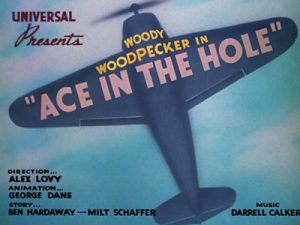 Ace in the Hole – (Lantz/Universal, Woody Woodpecker, 6/22/42 – Alex Lovy, dir,) – Instead of hus usual popping out from a tree or a panel of wood on the opening titles, Woody’s head pops out the bottom of a flying plane, for this unusual episode presenting Woody’s brief stint in military service. Assigned to a cavalry stable as stable boy, Woody dreams of bigger and better assignments, dallying from his duties to read a book titled “How to Fly a Plane – From the Ground Up.” Seeing a plane soaring overhead, Woody repeats the Terrytoons gag of hopping upon its ground shadow to hitch a ride. The shadow passes over several stacked piles of aerial bombs, giving Woody a bouncy jostling ride, finally throwing him into the belly of his sergeant, a tough bulldog. “Still playin’ pilot”, inquires the Sarge. “Yeah”, responds Woody, “And someday, I’m gonna pilot the Clipper,” “Well, them – – PILOT THIS CLIPPER!”. shouts the sergeant, handing Woody an electric horse clipper. “What a sense of humor”, Woody mutters, as he attends to trimming a horse. Another plane passes overhead, performing a loop de loop. Woody is so busy watching it, he fails to notice that his hand is tracing the path of the plane, carving a loop curve into the horse’s hair. Then his clipper hand shifts to another surface, and he traces an upward climb – carving the buttons off the chest of the sergeant’s uniform, and etching a bare path up the sergeant’s chin. Suddenly realizing the stop of his progress by the sergeant’s protruding lip, Woody gulps nervously in anticipation of what is coming. Woody guessed right, as the sergeant winds up Woody’s tail feathers like the prop blades on a toy plane, and pitches him across the camp under propelled power. Woody crashes into a post inside a building marked “Pilots’ Locker Room”. “How’d ya like your first solo flight?” calls out the laughing sergeant.
Ace in the Hole – (Lantz/Universal, Woody Woodpecker, 6/22/42 – Alex Lovy, dir,) – Instead of hus usual popping out from a tree or a panel of wood on the opening titles, Woody’s head pops out the bottom of a flying plane, for this unusual episode presenting Woody’s brief stint in military service. Assigned to a cavalry stable as stable boy, Woody dreams of bigger and better assignments, dallying from his duties to read a book titled “How to Fly a Plane – From the Ground Up.” Seeing a plane soaring overhead, Woody repeats the Terrytoons gag of hopping upon its ground shadow to hitch a ride. The shadow passes over several stacked piles of aerial bombs, giving Woody a bouncy jostling ride, finally throwing him into the belly of his sergeant, a tough bulldog. “Still playin’ pilot”, inquires the Sarge. “Yeah”, responds Woody, “And someday, I’m gonna pilot the Clipper,” “Well, them – – PILOT THIS CLIPPER!”. shouts the sergeant, handing Woody an electric horse clipper. “What a sense of humor”, Woody mutters, as he attends to trimming a horse. Another plane passes overhead, performing a loop de loop. Woody is so busy watching it, he fails to notice that his hand is tracing the path of the plane, carving a loop curve into the horse’s hair. Then his clipper hand shifts to another surface, and he traces an upward climb – carving the buttons off the chest of the sergeant’s uniform, and etching a bare path up the sergeant’s chin. Suddenly realizing the stop of his progress by the sergeant’s protruding lip, Woody gulps nervously in anticipation of what is coming. Woody guessed right, as the sergeant winds up Woody’s tail feathers like the prop blades on a toy plane, and pitches him across the camp under propelled power. Woody crashes into a post inside a building marked “Pilots’ Locker Room”. “How’d ya like your first solo flight?” calls out the laughing sergeant.
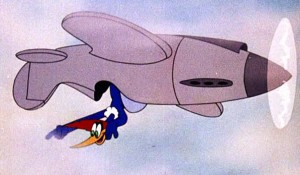 As Woody pries his beak loose from the post, he becomes aware of his surroundings, and of a well-padded pilot’s outfit for high altitude flying hanging on the wall. Woody decides to try it on for size, but is so short, the zipper pulls up over his head, sealing him inside. “What’s the matter with the zip in this zipper?”, complains Woody, struggling blindly with the zipper handle to get loose. He bumps into the wall, knocking down upon him a signal flare, with a lighting pin in nearly the same shape as the zipper handle, which falls into the neck of his flight jacket. Still feeling around for the zipper, Woody pulls the pin on the flare instead. He zips around the locker room, out the door, and into the sky, where the flare explodes. Woody sails back down to earth with the remnants of the pilot suit forming a parachute. He lands in the cockpit of a camouflaged fighter plane, the PU-2. “Gee, whillakers”, shouts Woody, at last behind the controls of a real plane. The sergeant spots him, and orders him to get out. But Woody’s not sticking around for discipline. Staring at the confusing control panel, Woody covers his eyes, and randomly points his finger at the buttons, reciting “My mother told me to take this one.” The plane takes off with such speed, it leaves behind all its camouflage paint (an economic move, making life simpler for the animators in the forthcoming shots). The plane heads straight for a stone wall. Woody pulls back on the stick, and, instead of going upwards, the plane compresses just short of the wall and screeches to a halt, then turns inside out to reverse directions. It chases the sergeant through hangar 13, flattening him against the wall with the hangar doors. The plane turns upside down, as Woody calls out, “Look, Sarge! No hands!” Then Woody falls out of the cockpit. “No plane, either”, he adds. But the unpiloted plane performs a loop, catching Woody in mid-fall. One of the earliest uses appears of a later oft-repeated gag, as Woody approaches two barracks buildings too close together to accommodate his wingspan between. Woody tilts the plane sideways, allowing the wings to pass through, while carving a semicircle out of each building’s sides with his propeller to allow the fuselage to pass, with several soldiers looking out from the hole as he passes through. The sergeant plays cowboy, and manages to catch the plane’s nose with a rope lasso. But the plane never loses speed, and yanks the sergeant right out of his uniform, reducing him to red long johns. He climbs the rope until he is just under the belly of the plane, and knocks upon a belly hatch door, demanding to be let in.
As Woody pries his beak loose from the post, he becomes aware of his surroundings, and of a well-padded pilot’s outfit for high altitude flying hanging on the wall. Woody decides to try it on for size, but is so short, the zipper pulls up over his head, sealing him inside. “What’s the matter with the zip in this zipper?”, complains Woody, struggling blindly with the zipper handle to get loose. He bumps into the wall, knocking down upon him a signal flare, with a lighting pin in nearly the same shape as the zipper handle, which falls into the neck of his flight jacket. Still feeling around for the zipper, Woody pulls the pin on the flare instead. He zips around the locker room, out the door, and into the sky, where the flare explodes. Woody sails back down to earth with the remnants of the pilot suit forming a parachute. He lands in the cockpit of a camouflaged fighter plane, the PU-2. “Gee, whillakers”, shouts Woody, at last behind the controls of a real plane. The sergeant spots him, and orders him to get out. But Woody’s not sticking around for discipline. Staring at the confusing control panel, Woody covers his eyes, and randomly points his finger at the buttons, reciting “My mother told me to take this one.” The plane takes off with such speed, it leaves behind all its camouflage paint (an economic move, making life simpler for the animators in the forthcoming shots). The plane heads straight for a stone wall. Woody pulls back on the stick, and, instead of going upwards, the plane compresses just short of the wall and screeches to a halt, then turns inside out to reverse directions. It chases the sergeant through hangar 13, flattening him against the wall with the hangar doors. The plane turns upside down, as Woody calls out, “Look, Sarge! No hands!” Then Woody falls out of the cockpit. “No plane, either”, he adds. But the unpiloted plane performs a loop, catching Woody in mid-fall. One of the earliest uses appears of a later oft-repeated gag, as Woody approaches two barracks buildings too close together to accommodate his wingspan between. Woody tilts the plane sideways, allowing the wings to pass through, while carving a semicircle out of each building’s sides with his propeller to allow the fuselage to pass, with several soldiers looking out from the hole as he passes through. The sergeant plays cowboy, and manages to catch the plane’s nose with a rope lasso. But the plane never loses speed, and yanks the sergeant right out of his uniform, reducing him to red long johns. He climbs the rope until he is just under the belly of the plane, and knocks upon a belly hatch door, demanding to be let in.
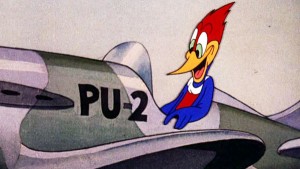 The door opens, but he is never able to enter, his path blocked by the escaping of about eight bombs, which collect in the drop seat of the sarge’s underwear. The bombs are followed by Woody himself, who stands on the shoulders of the sergeant, covering the sarge’s eyes and asking his favorite question – “Guess who?’ The sergeant turns to get a stranglehold on Woody, forgetting he is letting go of the rope in the process. Loaded with live ammo, the sergeant shrieks at the sight of the oncoming ground below. Woody also reacts with a Lou Costello whistle, but calmly pulls a ripcord, releasing a hidden parachute to keep him safely above the impact of the explosion which occurs beliw. The scene dissolves to another day, with the sergeant in a wheelchair and partial traction, but holding a rifle at the ready, acting as sentry to oversee the activities of his private. Woody, at gunpoint, is back at his horse clipper duties – but this time, a line of horses waits for their respective turns, extending to the horizon. Woody looks at the camera in dismay, giving the audience another Lou Costello whistle, as we fade out. (On a personal note: While the remainder of the Walter Lantz studio art collection was on deposit at UCLA’s libraries decades ago, before its donation to the Smithsonian, I, being the only volunteer familiar with this film, personally organized in numeric sequence a large manila envelope containing the original storyboard sketches, complete with pinholes where they had been posted for original review by the staff, from this film, placing numbers of their original order in light pencil on the corners of the reverse sides of the drawings for easy reconstruction later. The boards followed the final film very closely, with two minor differences. An extra line of dialogue appeared while Woody and the sergeant began falling with their load of bombs toward the ground, Woody asking the sergeant, “Mind if I look over your shoulder?” The other change was in the last shot, which had been illustrated in an oversize drawing in charcoal pencil on a full sheet of animation paper folded in quarters, showing the line of horses in great detail. Instead of merely clipping and giving the Costello whistle, Woody is depicted as carving into the horse’s flank hair with the clippers the letters, “The End”).
The door opens, but he is never able to enter, his path blocked by the escaping of about eight bombs, which collect in the drop seat of the sarge’s underwear. The bombs are followed by Woody himself, who stands on the shoulders of the sergeant, covering the sarge’s eyes and asking his favorite question – “Guess who?’ The sergeant turns to get a stranglehold on Woody, forgetting he is letting go of the rope in the process. Loaded with live ammo, the sergeant shrieks at the sight of the oncoming ground below. Woody also reacts with a Lou Costello whistle, but calmly pulls a ripcord, releasing a hidden parachute to keep him safely above the impact of the explosion which occurs beliw. The scene dissolves to another day, with the sergeant in a wheelchair and partial traction, but holding a rifle at the ready, acting as sentry to oversee the activities of his private. Woody, at gunpoint, is back at his horse clipper duties – but this time, a line of horses waits for their respective turns, extending to the horizon. Woody looks at the camera in dismay, giving the audience another Lou Costello whistle, as we fade out. (On a personal note: While the remainder of the Walter Lantz studio art collection was on deposit at UCLA’s libraries decades ago, before its donation to the Smithsonian, I, being the only volunteer familiar with this film, personally organized in numeric sequence a large manila envelope containing the original storyboard sketches, complete with pinholes where they had been posted for original review by the staff, from this film, placing numbers of their original order in light pencil on the corners of the reverse sides of the drawings for easy reconstruction later. The boards followed the final film very closely, with two minor differences. An extra line of dialogue appeared while Woody and the sergeant began falling with their load of bombs toward the ground, Woody asking the sergeant, “Mind if I look over your shoulder?” The other change was in the last shot, which had been illustrated in an oversize drawing in charcoal pencil on a full sheet of animation paper folded in quarters, showing the line of horses in great detail. Instead of merely clipping and giving the Costello whistle, Woody is depicted as carving into the horse’s flank hair with the clippers the letters, “The End”).
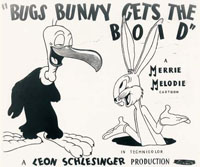 A final honorable mention is deserved by Bugs Bunny Gets the Boid (Warner, Bugs Bunny, 7/11/42 – Robert Clampett, dir.). This was, of course, the film that introduced Beaky Buzzard to the world. There are no actual planes depicted in the film – yet Bugs pulls a plane-related gag worthy of note. Beaky tiptoes through the clouds above Bugs’ rabbit hole, telling the audience, “I’m a-stalkin’ a victim.” He then soars in a circling dive from the heavens, his wings emitting the roaring sound of a power-diving plane. Bugs, nonchalantly reading a book of “Hare Raising Stories”, reacts with a spit-take of his partially-chewed carrot at becoming aware of the descending buzzard, and darts into his hole. Out of the hole pop his ears, with radio transmitter wires strung between them. To these wires is attached a microphone cord, and Bugs emerges with the mike and wearing radio headphones, playing the part of an air traffic controller. Though we have no idea if Beaky is wired for sound, Bugs sends out calls to talk Beaky in for his landing. “Come in, B-19 Come I, B-19. Ceiling, 500 feet. Visibility, 7 yards. Ehh, level off. Steady, now. Easy does it.” These instructions of course succeed in crashing Beaky in a nose dive into the ground, his tail straight up in the air like a plane fuselage after a crash. Bugs calmly observes the “wreckage”, and flicks a finger at Beaky’s tail, causing his rear end to collapse to the ground to meet the rest of him.
A final honorable mention is deserved by Bugs Bunny Gets the Boid (Warner, Bugs Bunny, 7/11/42 – Robert Clampett, dir.). This was, of course, the film that introduced Beaky Buzzard to the world. There are no actual planes depicted in the film – yet Bugs pulls a plane-related gag worthy of note. Beaky tiptoes through the clouds above Bugs’ rabbit hole, telling the audience, “I’m a-stalkin’ a victim.” He then soars in a circling dive from the heavens, his wings emitting the roaring sound of a power-diving plane. Bugs, nonchalantly reading a book of “Hare Raising Stories”, reacts with a spit-take of his partially-chewed carrot at becoming aware of the descending buzzard, and darts into his hole. Out of the hole pop his ears, with radio transmitter wires strung between them. To these wires is attached a microphone cord, and Bugs emerges with the mike and wearing radio headphones, playing the part of an air traffic controller. Though we have no idea if Beaky is wired for sound, Bugs sends out calls to talk Beaky in for his landing. “Come in, B-19 Come I, B-19. Ceiling, 500 feet. Visibility, 7 yards. Ehh, level off. Steady, now. Easy does it.” These instructions of course succeed in crashing Beaky in a nose dive into the ground, his tail straight up in the air like a plane fuselage after a crash. Bugs calmly observes the “wreckage”, and flicks a finger at Beaky’s tail, causing his rear end to collapse to the ground to meet the rest of him.
Next week: We’ll extend out flight range from the serious to the satiric, as the battles continue on.


 Charles Gardner is an animation enthusiast who toils by day as a member of LA Law – but by nights and weekends indulges in classic jazz and ragtime as a performer; and studies classic Hollywood cartoons… maybe a little too much.
Charles Gardner is an animation enthusiast who toils by day as a member of LA Law – but by nights and weekends indulges in classic jazz and ragtime as a performer; and studies classic Hollywood cartoons… maybe a little too much.



































































































































































I had no idea the swing tune “Life Goes to a Party” had anything to do with Life magazine. I always assumed it was a play on “Death Takes a Holiday”. You really do learn something new every day on Cartoon Research.
As for “The Bulleteers”, my guess is that, just as there was a Manhattan Project to develop nuclear weapons and a purported Philadelphia Experiment into invisibility, there must also have been a Metropolis Project for the purpose of designing a bullet-shaped car with a single unbreakable headlight, as well as an untraceable feedback-free public address system. Naturally the technology developed under this top-secret government project remains classified to this day. When the War Department cancelled the Metropolis Project (because it was a stupid idea to begin with), the scientists in charge went rogue and sought to obtain funding by stealing the city’s treasury — and they would have gotten away with it, too, if it hadn’t been for that meddling Kryptonian. The project’s research centre was later sold at government auction to Bruce Wayne, who turned it into the Bat Cave.
“Ace in the Hole” was one of the cartoons used in the first psychological study into the effects of cartoon violence on children. Please see Tom Klein’s excellent articles on this study, and the misuses to which it has been put over the years, elsewhere on this site.
That’s very interesting information about the original storyboard sketches to “Ace in the Hole”, and I believe there’s yet another line that was cut from the final cartoon. After Woody falls into the plane’s cockpit, he is clearly mouthing some words silently before he notices the letters PU-2 on the fuselage and says “Gee willikers, a real plane!” Any idea what line might have been cut there?
Re “Sham Battle Shenanigans”: this was actually inspired by the real problem of weapons shortages at the outbreak of the war, leading to troops doing training maneuvers with mock wooden rifles, telephone poles for “cannon” and jeeps or trucks with signs labelled “tank.” It was a genuine scandal in the news at the time. Bill Mauldin also did a couple of cartoons about it.
Here is a link to a much-better copy of “Wolf Chases Pigs”:
https://www.youtube.com/watch?v=pcM_Vl6girg
Thanks for that link. We’ll keep the copy we have embed in the post as is – as it has the original Columbia logos, the contrast is better (IMHO) and I even think the sound is better. But we always appreciate readers sending in better links to our videos.
And here’s a non-Chris Smalls the Video Stealer upload of Cinderella Goes to a Party, originally uploaded by Matt Skwarek (note his channel is invaded with comments by Ovidiu-Adrian Sabie)
https://www.youtube.com/watch?v=95IHvlNKkCM
They look identical to me. Both are from a down & dirty transfer I made from a 16mm film print provided by Mark Kausler.
I don’t remember Ollie ever saying that to Stan. It’s usually, “Well here’s another nice mess you’e gotten me into.” Cue Stan whimper.
The line comes from “Pack Up Your Troubles”, as Ollie reads the headlines about war declared to Stan.
I remember watching Cinderella Goes To A Party on tv when I was five or six. I never knew the name of the cartoon or what studio made it until now. Thanks for clearing it up for me.
“The Outpost” (Terrytoons/Fox, Gandy Goose, 10/7/41 — Mannie Davis, dir.) finds Gandy and Sourpuss stationed on a remote Pacific island, when they’re attacked by a squadron of Japanese bombers. They shoot down the planes, and then board a Japanese battleship manned by squint-eyed, buck-toothed pigs. This wartime cartoon is rarely seen, but there are extant 16mm prints, and I’d love to have a look at it someday.
“Cat Meets Mouse” (Terrytoons/Fox, 20/2/42 — Mannie Davis, dir.) concerns a house cat who captures mice and imprisons them in a box disconcertingly labelled “Concentration Camp”. One mouse manages to sound the Assembly bugle call on a harmonica, summoning an army of mice in Royal Canadian Mounted Police uniforms to the rescue. The cartoon’s sole aeronautical reference is when a squadron of Mountie mouse paratroopers jump out of an airplane and waft into the house through an open window. After a lengthy battle sequence, the army liberates the mice from the Concentration Camp box and imprisons the cat in it; and when asked what he has to say for himself, the cat can only whine in a Lou Costello voice: “I’m a bad boy!”